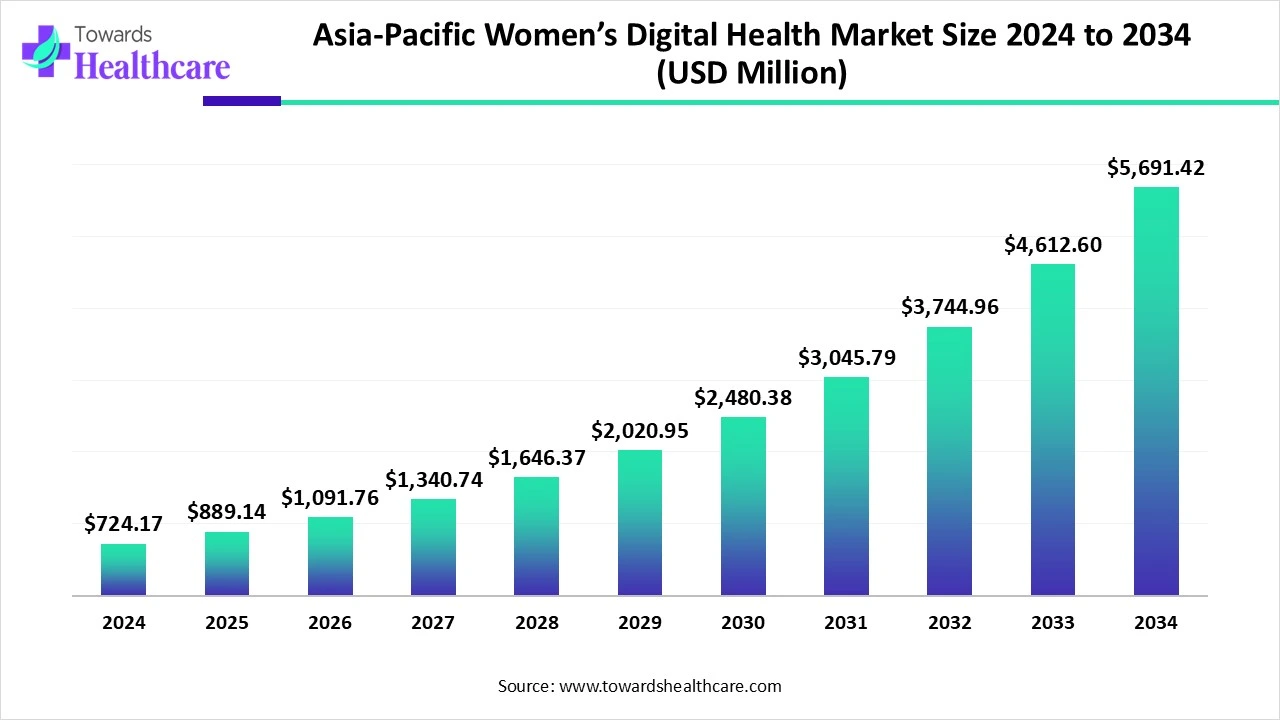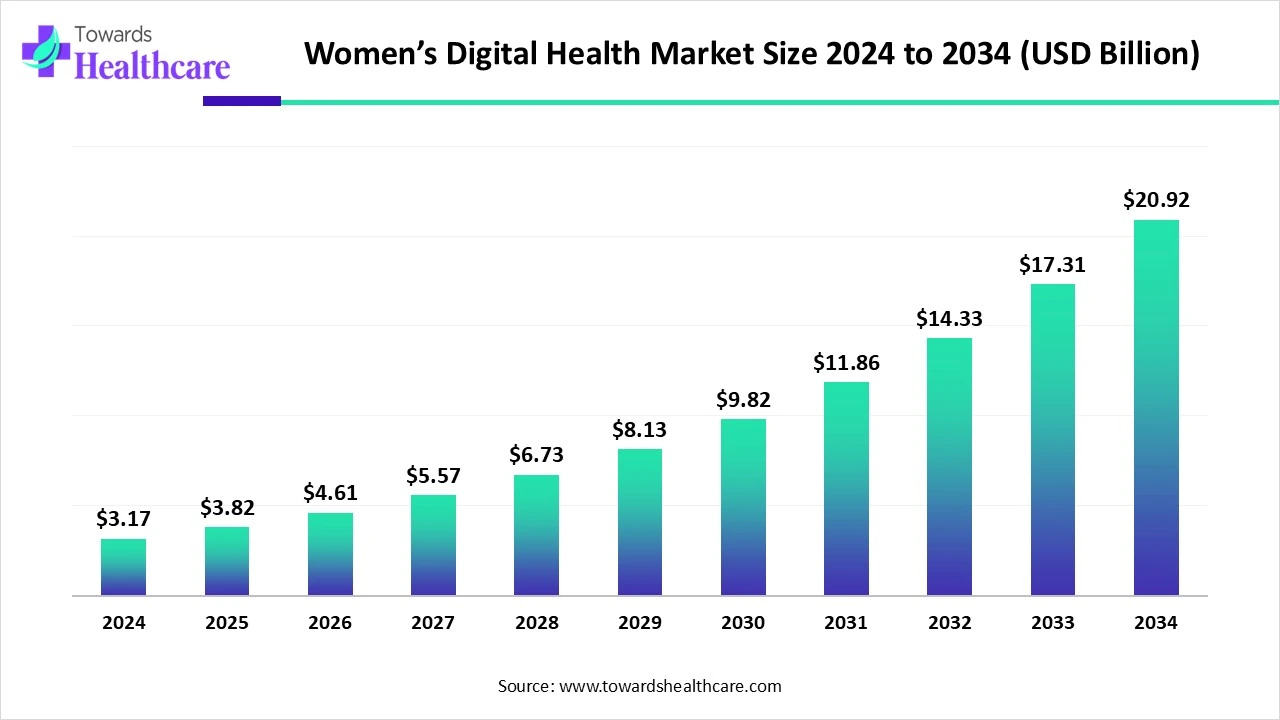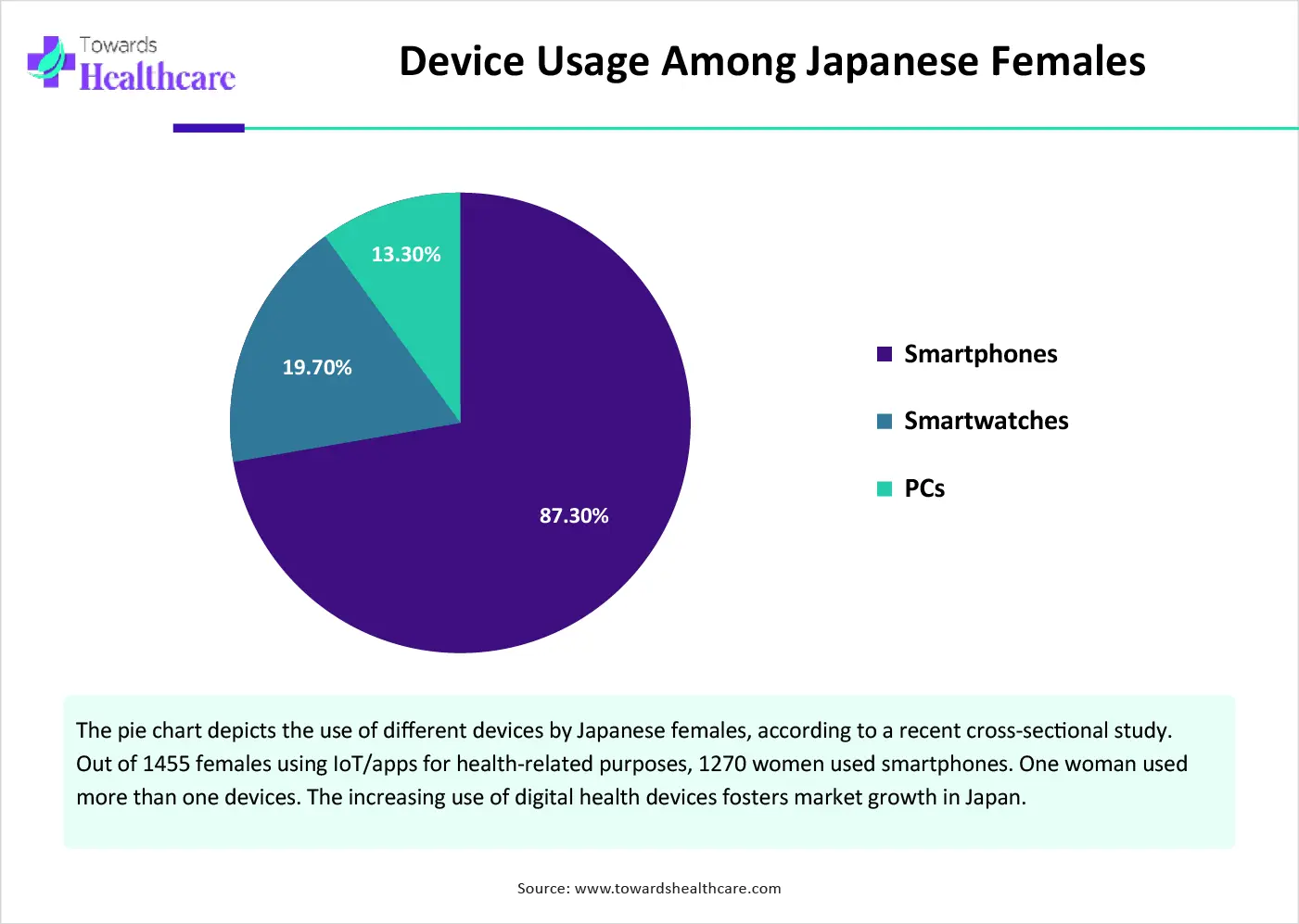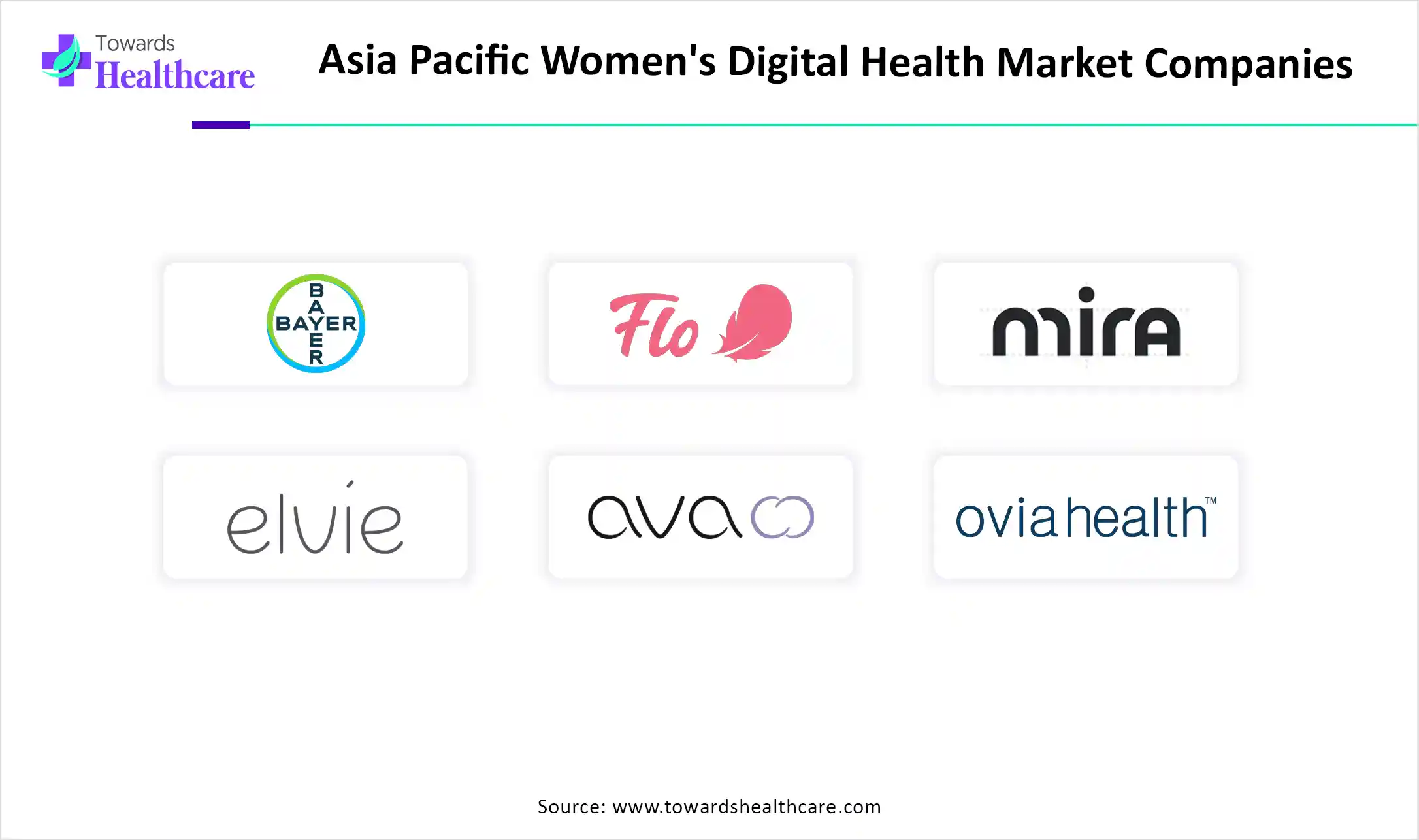December 2025

The Asia-Pacific women’s digital health market size is calculated at USD 724.17 million in 2024, grew to USD 889.14 million in 2025, and is projected to reach around USD 5691.42 million by 2034. The market is expanding at a CAGR of 22.74% between 2025 and 2034.
The Asia-Pacific women’s digital health market is primarily driven by the rising prevalence of chronic disorders and the increasing adoption of advanced technologies. Women in the Asia-Pacific region are becoming increasingly aware of their personal health and prefer using digital tools. Government organizations support the use of digital tools through initiatives and funding. The future looks promising, with the advancements in technology and the development of innovative digital tools.

| Metric | Details |
| Market Size in 2025 | USD 889.14 Million |
| Projected Market Size in 2034 | USD 5691.42 Million |
| CAGR (2025 - 2034) | 22.74% |
| Market Segmentation | By Product Type, By Application, By End Use, By Technology, By Delivery Mode, By Region |
| Top Key Players | Clue (Bayer AG), Flo Health Inc., Mira Fertility, Elvie, Ava Science Inc., Ovia Health (Eden Health Group), Natural Cycles, Glow, Inc., Maven Clinic, Progyny, Babyscripts, Medtronic, Philips Healthcare, GE Healthcare, Samsung Electronics (Health Division), Xiaomi Corporation (Mi Health & Wearables), 1mg Technologies (India), Practo Technologies (India), Halodoc (Indonesia), Alodokter (Indonesia) |
The global women’s digital health market is on the rise. Valued at USD 3.17 billion in 2024, it’s expected to grow to USD 3.82 billion in 2025 and reach around USD 20.92 billion by 2034, with a strong annual growth rate of 20.54% from 2025 to 2034.

The Asia-Pacific women’s digital health market refers to the market encompassing digital health technologies and solutions designed specifically for women’s health in the Asia-Pacific region. This includes digital platforms, wearable devices, mobile applications, telehealth services, and software solutions targeting health issues unique to women, such as maternal health, fertility, menstrual health, menopause, and chronic conditions predominantly affecting women. The market aims to improve women’s health outcomes, access to care, awareness, and personalized health management through technology.
Numerous factors govern market growth, including the rising prevalence of chronic disorders related to women’s health and the increasing geriatric population. Major players are developing digital tools to enhance the accessibility and affordability of women’s health. Favorable government support and regulatory policies facilitate the widespread use of digital health tools. The growing demand for personalized treatment and the increasing use of smartphones potentiate market growth.
Artificial intelligence (AI) plays a vital role in women’s digital health by governing advanced care and enhancing precision. It allows real-time monitoring of patients by healthcare professionals, enabling them to make informed decisions. Integrating AI into telemedicine provides remote monitoring and virtual consultations. AI-based sensors in wearable devices can monitor the vital signs of women’s health. Leveraging AI in diagnostic tools enables healthcare professionals to detect minute changes that are otherwise difficult to detect by humans. Thus, AI can improve disease detection, operational efficiency, and clinical decision support.
Demand for Telehealth
The major growth factor of the Asia-Pacific women’s digital health market is the growing demand for telehealth services. Telemedicine enables women from rural areas to access advanced healthcare, ensuring remote monitoring. Healthcare professionals can get real-time insights into a patient’s health, allowing them to make proactive decisions. The increasing use of smartphones and other devices has potentiated the demand for telehealth services. According to the GSMA report, there will be approximately 1.4 billion 5G connections in the Asia-Pacific region, equivalent to 41% of total mobile connections, by the end of 2030. (Source - Economic times)
Access to Rural Areas
Women from rural areas, especially from underdeveloped and developing countries, lack access to advanced tools and technologies. They refrain from such cutting-edge technologies, limiting their accessibility and affordability.
What is the Future of the Asia-Pacific Women’s Digital Health Market?
The future of the market is promising, driven by the development of novel and innovative diagnostic tools to revolutionize women’s health. The growing demand for point-of-care diagnostics also enables women to diagnose their conditions in the comfort of their homes. The increasing research and development activities favor the development of novel tools. Researchers have developed portable testing systems and self-collected vaginal swabs for human papillomavirus, enabling healthcare workers to bring to remote communities. AI-driven ultrasound imaging systems can accurately identify high-risk pregnancies and estimate gestational age. The development of such innovative devices is a result of increasing research activities and funding.
By product type, the mobile health applications segment held a dominant share of approximately 40% of the market in 2024. The segment dominated due to the increasing use of smartphones and advancements in connectivity technology. Mobile health applications perform a wide range of activities, including virtual consultations, medical records, and medication history. The availability of user-friendly health applications augments the segment’s growth. These applications improve access to healthcare information, especially in remote areas.
By product type, the wearable devices segment is expected to grow at the fastest CAGR in the market during the forecast period. The advent of wearable devices and advancements in AI-based sensors promote the segment’s growth. Wearable devices enable real-time monitoring of vital signs, such as non-invasive glucose monitoring, fertility tracking, and other data related to women’s health. The ease of use and cost-effectiveness also potentiate the demand for wearable devices.
By application, the fertility & pregnancy management segment led the global market with a share of approximately 35% in 2024. This is due to the increasing prevalence of infertility and the rising number of pregnant women. Most women from the countries in the APAC region have a fertility rate of 2.1 live births per woman. Numerous government and private organizations collaborate to deliver life-saving information on healthy behaviors and risk management during pregnancy. Digital health tools eliminate the need for a pregnant woman to physically visit a healthcare organization.
By application, the mental health & wellness segment is expected to grow with the highest CAGR in the market during the studied years. Mental health disorders, such as depression, anxiety, and eating disorders, are common in women. According to the Ipsos World Mental Health Day Report 2024, 40% of the global Gen Z women are most likely to experience low points or feel depressed. (Source - Ipsos) Digital health tools help to prevent, diagnose, and manage mental health disorders in women.
By end-user, the individual consumers segment held the largest revenue share of approximately 50% of the market in 2024. This segment dominated because of the availability of affordable digital health tools and the growing demand for personalized care. Women mostly use digital tools to continuously monitor their health and understand their health habits, and make informed decisions about their conditions. Some common examples of digital health tools used by individual consumers include mobile health applications and wearable devices.
By end-user, the telemedicine providers segment is expected to expand rapidly in the market in the coming years. The growing demand for remote monitoring propels the segment’s growth. Telecommunication technologies enable continuous, connected care. Telemedicine providers improve access to healthcare, increase convenience, and potentially reduce costs through digital tools. Such tools allow physicians to provide personalized consultations and services. Providers can also expand their services in various countries.
By technology, the cloud-based platforms segment contributed the biggest revenue share of approximately 45% of the market in 2024. The demand for cloud-based platforms is increasing, as they can store large amounts of patient data. Healthcare professionals and patients can access medical data from anywhere and at any time using cloud-based platforms. These platforms help digitize and unify organizations to simplify workflows. Healthcare professionals can also transfer a patient’s medical data to other providers globally and receive expert advice.
By technology, the artificial intelligence and machine learning segment is expected to witness the fastest growth in the market over the forecast period. AI and ML can perform multiple functions and analyze patient conditions. They suggest effective treatment solutions to patients and also alert healthcare professionals when a woman’s health deteriorates. They also provide notifications to remind patients about medications and scheduled appointments. Thus, AI/ML provide early disease detection, more effective treatment strategies, leading to improved patient outcomes.
By delivery mode, the mobile-based platforms segment held a major revenue share of approximately 55% of the market in 2024. The increasing use of smartphones and the growing awareness of mobile health apps for women's health foster the segment’s growth. Mobile-based platforms help maintain privacy and provide complete control over a patient’s medical data. It is estimated that mobile apps are faster than web-based healthcare apps due to their ability to access a phone’s systems and internet connections.
By delivery mode, the web-based platforms segment is expected to show the fastest growth over the forecast period. Web-based platforms run on a web browser and are accessed over the internet. Unlike mobile applications, they do not need to be installed on a device. They can be accessed by multiple users simultaneously. Developers can easily update web-based platforms without requiring any action from the user.
The Asia-Pacific women’s digital health market is governed by various factors, including the growing awareness of digital health among women and the rising prevalence of chronic disorders. The use of digital tools is supported by government organizations of numerous APAC countries. The increasing adoption of advanced technologies and the growing demand for personalized care augment the market. The rising investments and collaborations among key players facilitate the development of novel digital tools. The growing geriatric population is also a major concern, as the geriatric population is more prone to developing chronic conditions.
Around 9.54 million babies were born in China in 2024, an increase of 9.02 million from 2023. There were around 310 million people aged 60 years and above in 2024. It is reported that over 83% of Chinese tertiary hospitals use mHealth apps to schedule appointments and provide other services. The APACMed organized a webinar titled “China’s Digital Health and AI Priorities for the MedTech Industry” in 2025 to highlight policy messages and government priorities (Source - Apacmed)
It is found that India has the second-highest maternal mortality rate in the world. However, the maternal mortality rate declined to 97 per lakh live births in 2018-20. Favorable government initiatives, like Ayushman Bharat Digital Mission (ABDM) and the Digital Health Incentive Scheme (DHIS), are making significant strides in digital healthcare transformation. (Source - Azadi ka Amrut Mahotsav) The Indian government offers Tele MANAS services to improve access to quality mental health counselling. As of January 2025, more than 17.6 lakh calls were handled on the helpline number. (Source: Azadi ka Amrut Mahotsav)
Almost one-third of the Japanese population is aged 65 years and above, accounting for 36.25 million. Of these, 20.53 million are women and 15.72 million are men. (Source - Aljazeera) The Japan Agency for Medical Research (AMED) developed WaiSE, a diagnostic app for women based on sex-/gender-specific medicine. (Source - Japan) According to a recent cross-sectional study in Japan on 10,000 females, 14.6% of women were actively using health-related IoT or apps, 7% had used them previously, and 78.5% of women never used IoT or apps. (Source - National Library of Medicine)


Noha Salem, Executive Director, Organon Global Policy & Government Relations, commented that addressing fertility challenges faced by couples requires a coordinated approach involving medical, economic, and social factors. She encourages governments across APAC to prioritize infertility as a disease and integrate fertility care into national healthcare strategies. (Source - Express healthcare)
By Product Type
By Application
By End Use
By Technology
By Delivery Mode
By Region
December 2025
December 2025
December 2025
December 2025